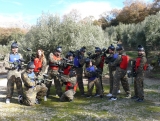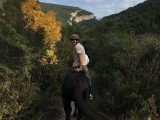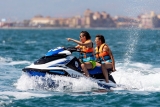Vallibierna Peaks (3,067 m)
Route 1. Forest Refuge - Vallibierna Pass - Vallibierna Peaks - Culebras Gully - Forest Refuge. (MBEA, S3-S4. 1067 m).
Active tourism lets you enjoy unique landscapes in the heart of nature. The route we offer ascends alongside the Vallibierna River, leaving the Llosás and Tempestades routes to the left, until reaching the Vallibierna tarns. Skiing down via the same itinerary is possible, although it is highly advisable to continue along the ridge to the next summit and complete a circular route via the impressive channel of Culebras Gully.

Remarks: an excellent viewpoint with a very interesting descent. The summit ridge is impressive, requiring skis to be removed, and includes the famous "Paso de Caballo" between the two peaks (rope advisable). A direct ascent and descent of the Culebras gully, a steep and sustained channel, is common.
Route 2. Llauset Reservoir - Llauset Pass - Vallibierna Peak. (BEA, S3. 932 m).
The route crosses or skirts the Llauset Reservoir, depending on whether it is frozen or not, and ascends westwards to the obvious Llauset Pass, south of Vallibierna Peak. From there, the ridge is climbed on foot to reach the summit. The descent follows the same itinerary.
Remarks: a remote and wild landscape. Access is quick, although it is important to check that the tunnel leading to the reservoir is open. The final ridge has some grade II sections that, depending on ability and experience, may require the use of a rope. Ski descent elevation is somewhat reduced. It is also possible, with a slight detour, to reach Vallibierna Pass from the Llauset Reservoir, connecting with the previous route towards its final stretch to complete a traverse.
Castanesa Peak (2,861 m)
Route 3. Vallibierna Forest Refuge – Estiba Freda Stream – Castanesa Pass – Castanesa Peak. (MBEA, S4. 1067 m)

From the refuge, you must cross the Vallibierna River at the best point and head decisively towards the Estiba Freda stream, which must be climbed. Initially, the path is somewhat confined, but it soon opens into a wide valley, allowing an ascent via broad, open slopes to the ridge. The summit lies further south, requiring a traverse across to a beautiful, flat, wide ridge leading to the peak.
Remarks: a privileged balcony overlooking the southern face of the Maladeta massif. This is an optimal traverse for beginners in ski touring or for days with less stable weather, offering an excellent descent via broad slopes. From the summit, it is also possible to descend directly to Cerler following a more complex route through the forest.
Russell Peaks (3,207 m)
Route 4. Vallibierna Forest Refuge – Llosás Stream – Russell Peaks. (BEA, S3. 1230 m).

The route initially follows the track towards Plan d'Están, then soon turns off towards the Llosás Stream. Following this stream through an increasingly narrow valley leads to the Llosás tarns. From here, a slope to the left climbs up to the base of the Russell summits. You can reach the main peak via a short climb to the ridge and a final section on foot. Descend via the same itinerary.
Remarks: a solitary and imposing landscape. A long and sustained ascent through a highly attractive, remote valley. Skiing from the summit requires a short foot ascent to the main ridge.
Tempestades Peak (3,290 m)
Route 5. Vallibierna Forest Refuge – Llosás Stream – Llosás Pass – Tempestades Peak. (BEA, S3-S4. 1330 m).
After following the Llosás Stream and reaching the tarns, continue westwards, ascending a succession of slopes leading to Llosás Pass, between Tempestades Peak and Aneto. The peak can be reached by climbing the final section of the ridge on foot.
Remarks: one of the lesser-visited peaks of the massif, offering magnificent views of the Aneto Glacier. The final section of the ascent involves exposed scrambling, and the use of a rope is recommended. This is a high mountain route, requiring caution and good conditions.
Margalida Peak (3,241 m)
Route 6. Vallibierna Forest Refuge – Tempestades Pass – Margalida Peak. (BEA, S4. 1360 m).

Follow the same route towards Llosás Pass as in the previous description. From the pass, traverse westwards towards Tempestades Pass, located between Tempestades and Margalida peaks. From there, a final ascent on foot leads to the summit. The descent can be made via the same itinerary.
Remarks: a more complex and demanding extension of the previous route. It includes a final ridge with sections of mixed snow and rock where additional mountaineering experience is advisable. The skiing is limited to the approach slopes, as the summit area itself is rocky and exposed.
Aneto (3,404 m)
Route 7. Vallibierna Forest Refuge – Coronas Valley – Coronas Glacier – Aneto. (BEA, S3-S4. 1660 m).
This route follows the track from Plan de Senarta to the Coronas Valley (the forest track is usually covered by snow). Continue along the valley to the Coronas tarns. Above the upper tarn, climb a steep slope leading to the foot of the Coronas Glacier. Ascend the glacier, veering left to reach the summit ridge. The final summit approach involves crossing the famous "Bridge of Mohammed" and a short scramble.

Remarks: the classic route from the southern side of Aneto, less frequented than the one from La Renclusa. A complete, varied, and demanding ascent, ideal for experienced ski mountaineers. Good glacier technique is essential. The final summit ridge is narrow and exposed.
Coronas Peak (3,293 m)
Route 8. Coronas Valley – Coronas Glacier – Coronas Peak. (BEA, S3. 1550 m).
The itinerary shares the same approach as the Aneto route until the upper part of the glacier. From there, a detour to the right allows the Coronas summit to be reached without crossing the Bridge of Mohammed. Descent via the same route.
Remarks: an interesting alternative to Aneto. It is easier and less exposed at the summit. Although it requires glacier travel, it avoids the most technical final ridge section of Aneto.
Maldito Peak (3,350 m)
Route 9. Vallibierna Forest Refuge – Coronas Valley – Maldito Glacier – Maldito Peak. (BEA, S4. 1660 m).
Follow the track towards the Coronas Valley as described in previous routes. Upon reaching the Coronas tarns, ascend towards the Maldito Glacier, turning off to the east. Climb the glacier directly up to the saddle between Maldito and Aneto. From there, a short ascent along the ridge leads to the summit.
Remarks: a spectacular and somewhat more demanding alternative to the classic Aneto route. The glacier ascent is steeper and the final ridge is sharper. Excellent views of Aneto and the surrounding peaks.
Aragüells Peak (3,037 m)
Route 10. Vallibierna Forest Refuge – Aragüells Valley – Aragüells Peak. (BEA, S2-S3. 1230 m).
From the refuge, head up the Aragüells Valley, a less-travelled valley than Coronas. Gradually ascend, passing several minor tarns and snowfields until reaching the saddle between Aragüells and Aneto. From here, a final short slope leads to the summit.

Remarks: a relatively straightforward and safe ascent, ideal as a first high-mountain ski mountaineering experience. The descent offers wide, enjoyable slopes. Less crowded than other classic routes in the area.
Tucas de Ixeia (2,837 m)
Route 11. Plan de Senarta – Vallibierna Valley – Ixeia Summit. (BEA, S2. 1110 m).
From Plan de Senarta, follow the Vallibierna Valley track. Upon reaching the Pleta de Llosás, head westwards ascending towards the Tucas de Ixeia. A final gentle slope leads to the summit area.
Remarks: a very accessible route with a pleasant and progressive ascent. The scenery is outstanding, and the descent is very enjoyable, with broad, moderate slopes perfect for good skiing.
Vallibierna Peak (3,056 m)
Route 12. Plan de Senarta – Vallibierna Valley – Vallibierna Peak. (BEA, S2-S3. 1260 m).
From Plan de Senarta, follow the track up the Vallibierna Valley. Pass the Llosás pastures and continue up the valley until reaching the Vallibierna tarn. From here, ascend southwards along wide slopes leading up to the summit ridge. Follow it eastwards to reach the summit.
Remarks: a classic and very beautiful route, combining a varied ascent with stunning views. The descent offers excellent slopes for skiing, especially in spring conditions. A very rewarding outing.
Tuca de Culebras (3,062 m)
Route 13. Plan de Senarta – Vallibierna Valley – Culebras Peak. (BEA, S2-S3. 1260 m).
Following the same approach as for Vallibierna Peak, once at the Vallibierna tarn, ascend westwards. A broad slope leads to the saddle between the two peaks. From here, a short final slope heads eastwards to the summit of Tuca de Culebras.

Remarks: a complementary or alternative objective to Vallibierna Peak. In good snow conditions, it is common to link both summits in a single outing.
Llosás Ridge Traverse
Route 14. Vallibierna Forest Refuge – Llosás Pastures – Llosás Ridge – Collado de Coronas. (BEA, S3-S4. 1450 m).
From the refuge, ascend the Vallibierna Valley to the Llosás pastures. From here, head westwards up the steep slopes towards the Llosás Ridge. Traverse the ridge, which is somewhat exposed in places, until reaching the Collado de Coronas. Descent along the classic Coronas route.
Remarks: a demanding route, requiring good alpine skiing technique and safe snow conditions. Highly panoramic, with close-up views of Aneto and the entire Maladeta massif.











